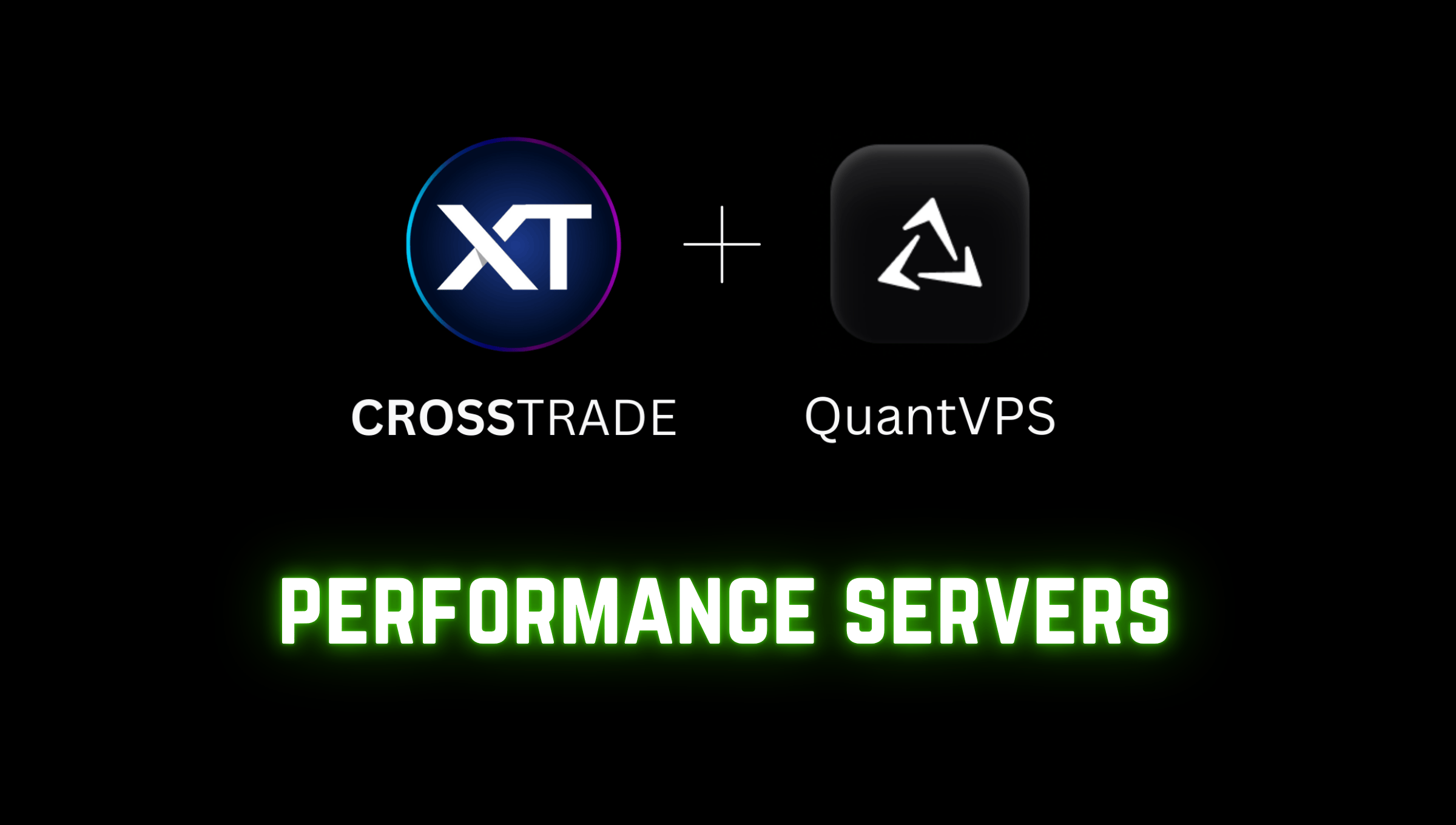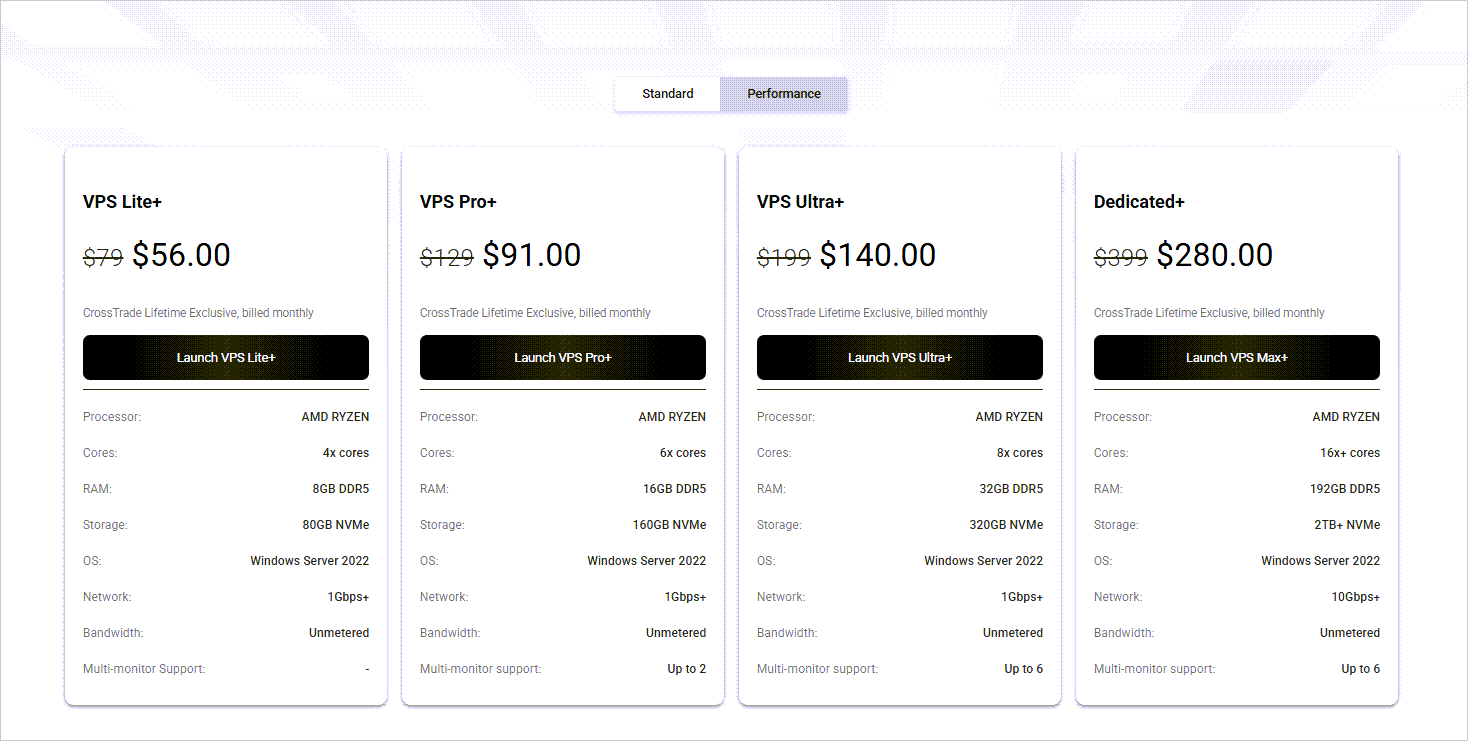QuantVPS Performance Line: Upgrade Your NinjaTrader Server with AMD Ryzen and DDR5
QuantVPS' new performance line uses AMD Ryzen CPUs and DDR5 memory for superior single-core performance. If you're scaling strategies or hitting resource limits, the hardware differences translate to measurable speed gains.

QuantVPS recently addressed the need for more modern focused servers with their Performance line—a tier above their already-solid Standard offerings. And if you're running CrossTrade for your TradingView-to-NinjaTrader automation, you can access these Performance servers at pricing that makes the upgrade decision considerably easier.
What Actually Changed: Standard vs. Performance
Let's cut through the marketing speak and look at what QuantVPS upgraded in their Performance line.
The Processor Shift: EPYC to Ryzen
The Standard line uses AMD EPYC processors—server-grade chips optimized for multi-core efficiency across general hosting tasks. They're reliable, cost-effective, and handle most trading workloads without breaking a sweat.
The Performance line switches to AMD Ryzen processors. Here's why that matters: Ryzen CPUs prioritize single-core performance over raw core count. For trading applications that process real-time market data and execute orders sequentially, higher single-core speed translates directly to faster execution. While EPYC chips might have more total cores, each Ryzen core is more powerful per cycle.
This isn't just theoretical. When your NinjaTrader strategy is processing tick data from the CME and making split-second decisions, that extra single-core horsepower means your orders reach the exchange faster.
Memory: DDR4 to DDR5
Standard plans use DDR4 RAM. Performance plans use DDR5.
DDR5 offers approximately 50% higher bandwidth than DDR4, which means faster data transfer between your CPU and memory. For traders running chart-heavy setups or multiple instances of NinjaTrader, this translates to smoother performance when handling large datasets and quicker access to cached market data.
If you're the type who keeps 20+ charts open with multiple indicators per chart, you'll notice the difference.
Storage and Network Specs
Both lines use NVMe storage and offer 1Gbps+ network connectivity with unmetered bandwidth, so you're not compromising on speed or data limits regardless of which tier you choose. Both are housed in QuantVPS's Chicago datacenter with sub-millisecond latency to CME—a critical advantage for futures traders.
The Performance line does offer more storage capacity across the board, which matters if you're logging extensive trade data or running multiple platform instances.
The Four Performance Tiers
QuantVPS structures their Performance line into four configurations:
VPS Lite+ gives you 4 cores, 8GB DDR5 RAM, and 80GB NVMe storage. It's the entry point for traders who need better single-core performance without going all-in on resources.
VPS Pro+ doubles the cores to 6 and RAM to 16GB, with 160GB storage. This tier handles multiple concurrent strategies or platform instances without resource contention.
VPS Ultra+ scales to 8 cores and 32GB RAM with 320GB storage. If you're running sophisticated multi-instrument strategies or need headroom for complex backtesting, this is where you start to have real breathing room.
Dedicated+ is the top tier with 16+ cores, 192GB DDR5 RAM, and 2TB+ NVMe storage. It also includes 10Gbps+ network connectivity and support for up to 6 monitors via RDP. This is overkill for most individual traders but makes sense for small prop firms or traders running dozens of strategies simultaneously.

When Standard Makes Sense (And When It Doesn't)
The Standard line isn't inferior—it's optimized differently. If you're running a straightforward strategy on one or two instruments, the Standard plans will serve you well at a lower price point.
You should consider the Performance line when:
- You're running multiple concurrent strategies that compete for CPU cycles
- Your charts and indicators are resource-intensive (lots of calculations per tick)
- You're experiencing any performance degradation during high-volatility periods
- You're scaling up the number of instruments or contracts you're trading
- You need faster backtesting for strategy development
The DDR5 memory alone makes a noticeable difference when you're pushing the limits of what your VPS can handle.
The CrossTrade Connection
For CrossTrade users specifically, there's a practical benefit: you're already routing TradingView alerts through CrossTrade's webhook system to trigger NinjaTrader orders. The faster your VPS can process those incoming webhooks and execute the corresponding trades, the less slippage you'll experience.
If you're using XT Alert Builder for complex signal logic or running multiple strategies through CrossTrade simultaneously, the Performance line's superior single-core performance means each webhook gets processed faster. The difference might only be a few milliseconds, but in fast-moving markets, those milliseconds add up to better fill prices.
Pricing Reality
The Standard line starts at $42/month for VPS Lite and scales to $210/month for the Dedicated tier.
The Performance line ranges from $56/month for VPS Lite+ to $280/month for Dedicated+.
That's roughly a 30-35% premium for the hardware upgrades. Whether that's worth it depends entirely on your trading volume and strategy complexity. If better execution saves you one tick per contract on a handful of trades, the server cost is negligible.
Through CrossTrade's partnership with QuantVPS, you can access the Performance line at pricing that narrows that gap considerably:
- VPS Lite+ | Normally 79.99 --> $56 with Code: CROSSTRADE
- VPS Pro+ | Normally 129.99 --> $91 with Code: CROSSTRADE
- VPS Ultra+ | Normally 199.99 --> $140 with Code: CROSSTRADE
- Dedicated+ | Normally 399.99 --> $280 with Code: CROSSTRADE
Windows Server 2022 and Multi-Monitor Support
All Performance plans come with Windows Server 2022 pre-installed and optimized for trading environments. Remote Desktop Protocol (RDP) support is configured out of the box, and plans from Pro+ upward support multiple monitors—up to 2 for Pro+, up to 6 for Ultra+ and Dedicated+.
If you manage your trading operation remotely (which you should be, that's the point of a VPS), having proper multi-monitor support through RDP makes your remote workspace actually usable rather than cramped into a single screen.
The Bottom Line
The Performance line exists because some trading strategies genuinely need better hardware. If you're running lean strategies on a handful of instruments, the Standard line will serve you fine and save you money.
But if you're scaling up, experiencing performance bottlenecks, or running resource-intensive strategies, the Performance line's upgrade to Ryzen processors and DDR5 memory provides measurable improvements in execution speed and system responsiveness.
The hardware differences aren't marketing fluff. Single-core performance matters for trading applications. Memory bandwidth matters when you're processing real-time data streams. When you factor in the performance upgrade, it becomes a straightforward cost-benefit calculation rather than a premium luxury.


